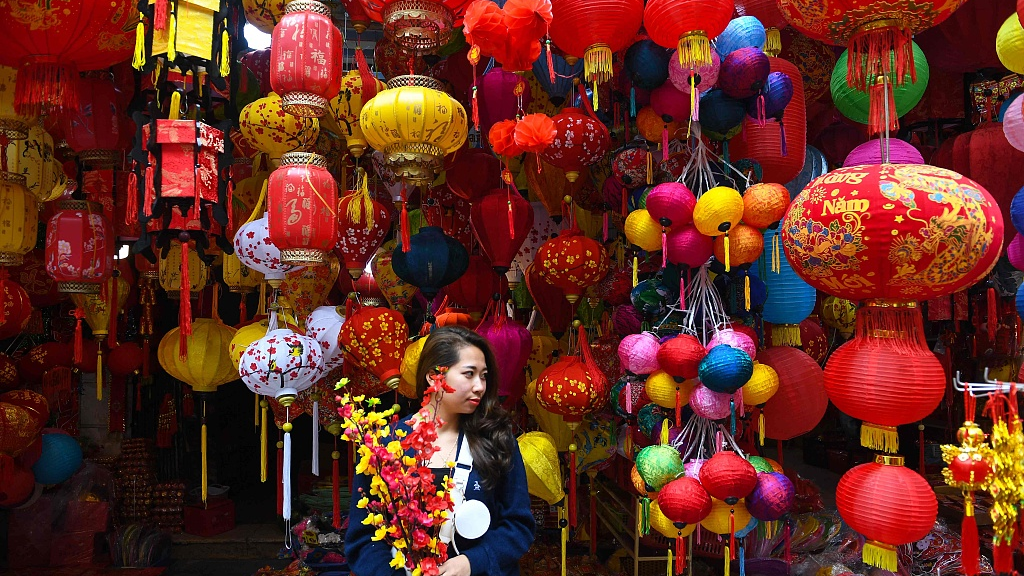
A shopkeeper poses for a photo in front of a shop selling decorations ahead of the Spring Festival, a traditional festival for both Vietnam and China, in the old quarter of Hanoi, Vietnam, January 11, 2022. /CFP
A shopkeeper poses for a photo in front of a shop selling decorations ahead of the Spring Festival, a traditional festival for both Vietnam and China, in the old quarter of Hanoi, Vietnam, January 11, 2022. /CFP
Editor's note: Hafijur Rahman, a special commentator on current affairs for CGTN, is a columnist and security and strategic analyst, working for a strategic studies center in Bangladesh. The article reflects the author's opinions and not necessarily the views of CGTN.
In a letter addressed to General Secretary of the Communist Party of Vietnam Central Committee Nguyen Phu Trong, on the occasion of the last Spring Festival, General Secretary of the Communist Party of China Xi Jinping eloquently expressed that "China and Vietnam are a community with a shared future that bears strategic significance." Nguyen earlier paid a three-day visit to Beijing in late October 2022 when both leaders pledged to elevate the unique bond of "comrades and brothers" relationship between the two nations to a new level.
In the field of culture, exchanges between China and Vietnam can be traced back to the Han Dynasty thousands of years ago. To this day, Chinese characters and Chinese-style buildings can still be seen on the streets of Vietnam, with Chinese TV dramas such as "The Legend of Chu Qiao" and "Empresses in the Palace" drawing attention from the youth in the Southeast country. Meanwhile, some Vietnamese songs have become popular online among Chinese young people.
Similar cultures, common ideological roots, parallel political structures, and akin economic development models have kindled deep warmth in the ties between these two nations, yielding tangible benefits for their respective populations. Over the course of time, these commonalities, combined with multidimensional exchanges and cooperation across economic, political, and military realms, have forged into a unique partnership.
In the intricate fabric of international relations, few partnerships stand as stalwart symbols of enduring camaraderie and shared aspirations as the dynamic China-Vietnam relations. The eternal rapport, carefully nurtured by President Ho Chi Minh and Chairman Mao Zedong and adeptly propelled forward by successive generations of leaders from both nations over the decades, stands today as a priceless shared asset between China and Vietnam.
Not long after its establishment, China was the first country in the world to establish diplomatic ties in 1950 with the Democratic Republic of Vietnam, now the Socialist Republic of Vietnam. The bilateral relations between China and Vietnam have a deeply rooted diplomatic history, guided by the principles of "friendly China-Vietnam relations for peace, stability, and prosperity." Both nations elevated their relations to comprehensive strategic cooperative partnership status in 2008.
Under the framework of 16-word guidelines encapsulating "friendly neighborliness, comprehensive cooperation, long-term stability, and future-oriented thinking" and inspired by the spirit of the "four good" principles – "good neighbors, good friends, good comrades, good partners," the enduring fraternal partnership has significantly burgeoned across party-to-party, state-to-state, and people-to-people dimensions.
Orchestrated primarily by the stewardship of the Communist Party of Vietnam and the Communist Party of China and actively advanced through a myriad of state-to-state collaborative mechanisms, this robust camaraderie has been further cemented over the decades by resilient cross-border trade and investment affiliations.
The 1,297km land border between China and Vietnam serves as a vital conduit for Chinese trade with Vietnam and the broader Southeast Asian region. Underpinned by the commitment to fostering a mutually beneficial and "win-win" economic relationship, China has been Vietnam's largest trade partner since 2004. Conversely, Vietnam currently holds the position of China's largest trading partner in ASEAN and China's fourth-largest trading partner by individual country. From merely $32 million in 1991, the two-way trade between the two countries has grown to $234 billion in 2022, highlighting the robust nature of their economic ties.

Vietnamese officials promote Vietnamese food via live broadcast during the 2021 South Asia and Southeast Asia Commodities Exhibition in Kunming, southwest China's Yunnan Province, August 25, 2021. /CFP
Vietnamese officials promote Vietnamese food via live broadcast during the 2021 South Asia and Southeast Asia Commodities Exhibition in Kunming, southwest China's Yunnan Province, August 25, 2021. /CFP
On the investment front, according to Vietnam's Ministry of Planning and Investment, China's direct investment in Vietnam reached $2.92 billion in the initial nine months of the year, marking a substantial 94.9 percent increase, compared to the same period in 2022. Holding the sixth position among 144 countries and territories contributing to foreign direct investment in Vietnam, China boasts over 4,000 active projects with a total registered capital surpassing $26 billion, showcasing its significant economic presence in the nation.
China has played a pivotal role in advancing Vietnam's infrastructure, spanning projects like the Seo Chong Ho hydropower plant and the ongoing construction of the Fangchenggang-Dongxing high-speed railway link. Beyond infrastructure, China has already bolstered Vietnam's supply chain by investing in mobile phone casings or facilities for electronic parts testing, further cementing its contributions to Vietnam's economic development.
People-to-people exchanges, notably between the young generations from the two countries, have become increasingly pragmatic, enriching mutual understanding and fortifying friendship between the two nations. Noteworthy exchange programs, such as the Vietnam-China Youth Friendship Meeting, the Vietnam-China Border Tourism Festival, and the Vietnam-China People's Forum, underscore the commitment to robust people-to-people connections. This vitality extends seamlessly to localities, notably within provinces along the shared border, where vibrant exchanges flourish.
Over the past seven decades, China-Vietnam relations have witnessed both peaks and occasional hiccups. Vietnam may have endeavored to re-calibrate its foreign policy in response to the current era of heightened geopolitical competition. Nonetheless, it remains steadfast in recognizing that its shared future is more intricately intertwined with none other than China, its fellow comrade and brother.
(If you want to contribute and have specific expertise, please contact us at opinions@cgtn.com. Follow @thouse_opinions on Twitter to discover the latest commentaries in the CGTN Opinion Section.)



